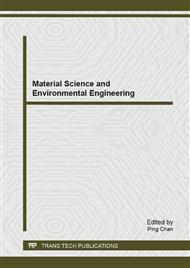p.200
p.207
p.214
p.218
p.224
p.231
p.237
p.244
p.248
Preparation, Characterization and Conductivity of Solid High-Proton Conductor Na7[CoW11O39Cd(H2O)]·12H2O
Abstract:
A new solid high-proton conductor Na7[CoW11O39Cd (H2O)]·12H2O has been synthesized for the first time. The percentage composition of the product were determined by Inductively coupled plasma (ICP) and X-ray photoelectron spectroscopy (XPS). The product was characterized by infrared spectroscopy (IR) and X-ray diffraction (XRD), which indicate it possesses the Keggin structure. The TG-DTA curve shows the sequence of water loss in the compound, the amount of the loss, as well as the thermostability. Conductivity of the compound was investigated by four-electrode method at room temperature and different measuring temperatures, the results reveal that its proton conductivity is 4.87×10−4 S·cm-1 at 27oC and the activation energy for proton conduction is 15.31 kJ/mol.
Info:
Periodical:
Pages:
224-228
Citation:
Online since:
May 2014
Authors:
Keywords:
Price:
Сopyright:
© 2014 Trans Tech Publications Ltd. All Rights Reserved
Share:
Citation:


